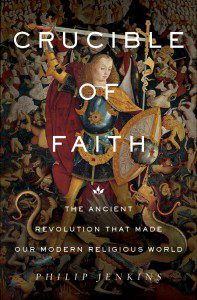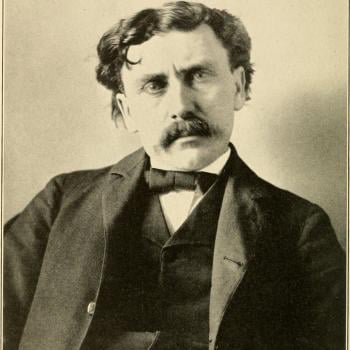My new book will be out shortly. This is Crucible of Faith: The Ancient Revolution That Made Our Modern Religious World (Basic Books, 2017). It will be available on September 19.
That “Crucible” refers to an era of revolutionary transformation that occurred in the Jewish and Jewish-derived world in the couple of centuries before the time of Jesus – roughly from 250 BC through the late first century BC. Or to adapt the publisher’s description:
The New Testament proclaims a mighty cosmic vision of Heaven and Hell, angels and Satan, the Messiah and the Apocalypse. Yet although all these ideas have their roots in the Old Testament, those earlier books imagined a very different and usually more limited spiritual universe than we find in historic Judaism and Christianity. What happened to alter religious thought so dramatically in the centuries following the closing of the Hebrew Bible?
In Crucible of Faith, Jenkins describes how the Judeo-Christian tradition we know today was born between 250–50 BC, during the turbulent “Crucible Era”—a time when Jews grappled with overwhelming forces of Hellenization and globalization. As a result, Judaism produced new religious ideas that responded to a changing world. The revolutionary politics of the 160s BC created an apocalyptic world-view where earthly struggles reveal a cosmic significance, a universe dominated by angels and demons; by the time of the fall of the Temple in 70 AD, concepts that might once have seemed bizarre became normalized—and thus passed on to Christianity and later Islam.
Drawing widely on contemporary sources from outside the canonical Old and New Testaments, Jenkins reveals an era of political violence and social upheaval that ultimately gave birth to entirely new ideas about religion, the afterlife, and the nature of God and Satan. Crucible of Faith describes one of the greatest revolutions in human thought.
Here is my argument.
Just over two thousand years ago, a new universe was created, one that we still inhabit today.
At the heart of Western religious thought, we find a group of very familiar stories, images and characters. To varying degrees, Christianity, Judaism and Islam all share a grand historical narrative that begins with Creation, the Garden of Eden and the Fall, and culminates in an apocalyptic conclusion to the world order. Featuring in this drama are a Messiah and Satan, as well as a host of lesser figures, of angels and demons, the forces of Light and Darkness locked in deadly combat until the Final Judgment. The setting is a hierarchical universe that includes a Heaven (or Heavens) and Hell, which will be the ultimate destinations for all living human beings. These are the familiar building blocks of Western religion, as well as the staples of two millennia of Western art.
However familiar and thoroughly “Biblical” the individual components of the story appear, they represented a radical departure from the belief system that we find in the Hebrew Bible, or what modern Protestants call the Old Testament. During the period covered by the Old Testament, up to around 400 BC, none of those ideas existed in Jewish thought, or if they did their role was strictly limited: not the Edenic Fall of Man nor the apocalypse, not the Messiah or Satan, neither Heaven nor Hell, not even an idea as essential as the afterlife. By the start of the Common Era though, these themes had achieved the complex and even florid form that has shaped Western faith and culture ever since.
Scarcely less innovative were the means by which humanity learned such cosmic truths, namely through sacred texts and scriptures that presented divine revelations. Although living teachers and charismatic prophet still mattered enormously, religious truths were chiefly conveyed through canonical scriptures.
So much of what we think of as the Judeo-Christian spiritual universe was only conceived and described after the closure of the canonical Old Testament text. Scholars have long known that the famous apocalyptic imagery derived from the New Testament Book of Revelation has a specific history rooted in worldly events of a particular historical era, in contemporary factions and conflicts. But so also does the End of the World, and Satan, and the Messiah, and so do angels and demons. All these ideas can be dated quite precisely to a startlingly little known historical era that has seldom received the attention it deserves. Virtually every component of that world-view entered the Jewish world in the two or three centuries before the Common Era.
It was in these years, after the closure of the Hebrew Bible, when the heavens and hells became so abundantly populated, and when the universe was conceived as a battleground between cosmic forces of Good and Evil. In the first centuries of the Common Era, such Jewish-derived themes spilled forth into the wider world, ultimately becoming transcontinental. In the seventh century AD, Islam fully absorbed and incorporated these religious components, which today are the shared cultural inheritance of well over half the world’s people.
Those critical centuries, before the turn of the Common Era, made the religious world the West has known ever since. Without this transformation, neither Christianity nor Islam would exist, and Judaism itself would have been unimaginably different.
Such a radical transformation of religious thought in such a relatively brief period makes this one of the most revolutionary times in human thought. Yet the fact of that change, and the profundity of its character, is rarely acknowledged. In terms of its impact on human culture – in creating Western consciousness – this era is at least as significant as the celebrated Axial Age that has been claimed several centuries earlier.
For over two centuries, the Jewish and Jewish-derived world was a fiery crucible of values, faiths and ideas, from which emerged wholly new religious syntheses. That era, and that transformation, is the subject of my Crucible of Faith.














